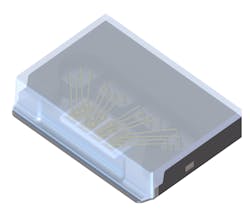High-performance, surface-mount-technology (SMT) LEDs are critical to applications like automotive LiDAR. I recently had a chance to talk with Osram’s Director of Visible LEDs, Michael Godwin.
Efficiency droop has been an issue for LEDs in the past. Wouldn’t that diminish LiDAR performance?
Efficiency droop is related to blue LEDs used in visible light. The components used in LiDAR and advanced driver-assistance systems (ADAS) applications are infrared (invisible) photonics solutions. Osram produces lasers for LiDAR systems. We also offer infrared LEDs (IREDs), vertical cavity surface emitting lasers (VCSELs), or edge emitting lasers (EELs) for various driver assistant systems such as driver monitoring, gesture control, and facial recognition.
What photonics technology does Osram have for the LiDAR market?
The latest addition to Osram’s photonics portfolio for LIDAR applications are two new high-power SMT lasers (Fig. 1) including the single-channel SPL S1L90A_3 A01 and four-channel device SPL S4L90A_3 A01. With the world's first AEC-Q102-qualified four-channel and single-channel pulse laser, system developers can now choose from an even greater variety of infrared components from Osram. The two new products offer performance of 125 W per channel and an efficiency of up to 33%.
How do Osram’s new two new infrared high-power SMT components for LiDAR applications help system developers?
The two new SMT lasers offer ease of use for the customer in their system integration because of their higher power and extended duty cycle range of up to 0.2%, allowing their customers to reach a longer detection range in the application and better resolution. Additionally, eye-safe system designs can be achieved with these high power 905-nm products. With its sophisticated package design, the new SMTs also enable short pulse widths of around 2 ns.
Tell me a little more about Osram’s photonics portfolio.
Osram is evolving into a high-tech champion of photonics. Our high-quality LEDs are used for visualization in many automotive applications such as the Osire E4633i that provides uniform color rendering across the entire color space and in dynamic light cases. Osram is also developing the second generation of Eviyos, the world's first hybrid LED with more than 25,000 pixels on a single LED. Eviyos, with its multifunctional, intelligently controllable headlamps, does more than just illuminate road ahead; it also projects HD-quality images on the ground to communicate with pedestrians and passengers.
Another great demonstration of our automotive photonics expertise is the Rinspeed microSNAP vehicle. The concept car features Osram’s infrared components for 3D facial recognition, iris scanning and gesture control, and passenger monitoring that scans the interior for forgotten objects after a rider leaves the vehicle. Our technological possibilities seem virtually endless.
Why are requirements for safety systems in semi-autonomous vehicles so complex?
The requirements for safety systems in semi-autonomous vehicles are complex. They must be reliable, work in all lighting and weather conditions, and identify potential hazards and obstacles in time to take appropriate driving decisions. There is now widespread agreement that only a combination of LiDAR, camera, and radar is able to fulfill autonomous driving requirements.
How do your infrared high-power SMT components for LiDAR applications help systems developers meet these safety requirements?
A central aspect in terms of safety is the range of the used infrared light source. A powerful laser is required to be able to look as far ahead as possible. Both products showcase an output power of 125 W, 40 A per channel. Thanks to its particularly low thermal resistance of only 30K/W for the single-channel SPL S1L90A_3 A01 and 17K/W for the four-channel SPL S4L90A_3 A01, heat is easily dissipated from the component—even at high currents. Osram introduced the first 905-nm laser to the market more than 10 years ago. Today it’s the most commonly used wavelength in LiDAR solutions. For instance, the 905 nm has a significant advantage compared to 1550-nm wavelength solutions, especially in terms of total system costs.
What types of applications can these new components enable?
The new components are for the LiDAR applications primarily used in autonomous driving. LiDAR can also be used in a number of other applications where 3D imaging is needed, such as agriculture, building construction, and environmental assessment (Fig. 2).
Michael S. Godwin is the Director for Visible LED products for Osram Opto Semiconductors Inc. In his role as Director, Mr. Godwin is responsible for product and marketing strategies for standard and custom LED products in the automotive, consumer, display, and projection market segments in the NAFTA market. Prior to being named Director, Mr. Godwin held the positions of Business Development Manager, General Marketing Manager, and Product Marketing Manager.
About the Author
Michael Godwin
Director, Visible LEDs, Osram Opto Semiconductors Inc.
Michael S. Godwin is the Director for Visible LED products for Osram Opto Semiconductors Inc. In his role as Director, Mr. Godwin is responsible for product and marketing strategies for standard and custom LED products in the automotive, consumer, display, and projection market segments in the NAFTA market. Prior to being named Director, Mr. Godwin held the positions of Business Development Manager, General Marketing Manager, and Product Marketing Manager.
Godwin joined Osram Opto Semiconductors in 1999 and assisted in establishing marketing and application teams focused on the automotive industry. Through his leadership, OSRAM was awarded as a finalist in the 2002 PACE Awards (Premier Automotive Commitment to Excellence) for white lighting on the Lincoln Navigator/Aviator. In addition, Osram also secured the 2006 PACE Award for Color on Demand and most recently the 2011 PACE award for OSRAM OSTAR HL in forward lighting applications. Prior to joining Osram Opto Semiconductors, Godwin worked as a sales manager and has experience in lighting manufacturing and quality management, flexible circuits, electrical interconnect, and sensors. He holds a Bachelor of Science in Materials Science and Metallurgical Engineering from Michigan Technological University.


